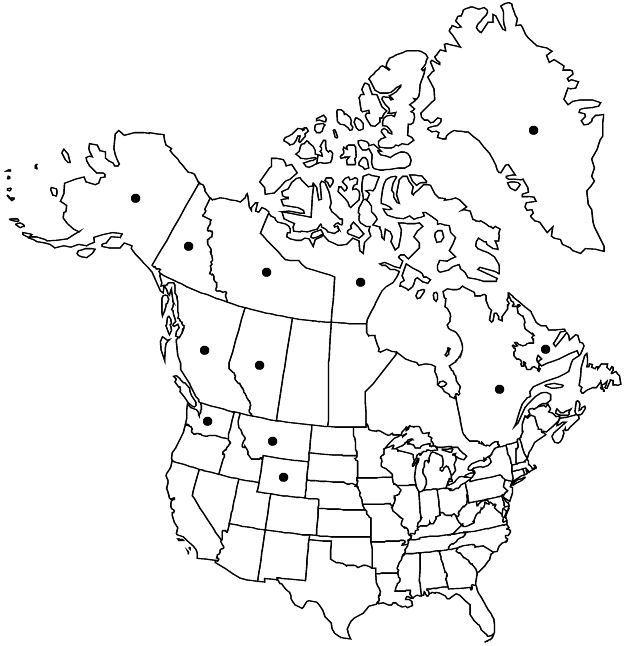Difference between revisions of "Potentilla hyparctica"
Rhodora 36: 177. 1934.
FNA>Volume Importer |
RevisionBot (talk | contribs) m (Bot: Adding category Revised Since Print) |
||
| (3 intermediate revisions by 2 users not shown) | |||
| Line 28: | Line 28: | ||
-->{{Treatment/Body | -->{{Treatment/Body | ||
| − | |distribution= | + | |distribution=Alta.;B.C.;N.W.T.;Nfld. and Labr.;Nunavut;Que.;Yukon;Alaska;Mont.;Wash.;Wyo.;n Eurasia;circumpolar. |
|discussion=<p>Subspecies 3 (2 in the flora).</p><!-- | |discussion=<p>Subspecies 3 (2 in the flora).</p><!-- | ||
--><p>Southern arctic and subarctic plants differ from the northern arctic ones in presumably independent features. Where the two forms are sympatric (western Greenland, northern Quebec, Baffin Island), they appear to remain distinct even in mixed populations and are accordingly treated as subspecies.</p><!-- | --><p>Southern arctic and subarctic plants differ from the northern arctic ones in presumably independent features. Where the two forms are sympatric (western Greenland, northern Quebec, Baffin Island), they appear to remain distinct even in mixed populations and are accordingly treated as subspecies.</p><!-- | ||
| Line 60: | Line 60: | ||
|basionyms= | |basionyms= | ||
|family=Rosaceae | |family=Rosaceae | ||
| − | |distribution= | + | |distribution=Alta.;B.C.;N.W.T.;Nfld. and Labr.;Nunavut;Que.;Yukon;Alaska;Mont.;Wash.;Wyo.;n Eurasia;circumpolar. |
|reference=None | |reference=None | ||
|publication title=Rhodora | |publication title=Rhodora | ||
|publication year=1934 | |publication year=1934 | ||
|special status=Illustrated | |special status=Illustrated | ||
| − | |source xml=https:// | + | |source xml=https://bitbucket.org/aafc-mbb/fna-data-curation/src/2e0870ddd59836b60bcf96646a41e87ea5a5943a/coarse_grained_fna_xml/V9/V9_291.xml |
|subfamily=Rosaceae subfam. Rosoideae | |subfamily=Rosaceae subfam. Rosoideae | ||
|tribe=Rosaceae tribe Potentilleae | |tribe=Rosaceae tribe Potentilleae | ||
| Line 73: | Line 73: | ||
}}<!-- | }}<!-- | ||
| − | -->[[Category:Treatment]][[Category:Potentilla sect. Aureae]] | + | --> |
| + | |||
| + | [[Category:Treatment]] | ||
| + | [[Category:Potentilla sect. Aureae]] | ||
| + | [[Category:Revised Since Print]] | ||
Latest revision as of 18:08, 6 November 2020
Plants cushion-forming; caudex branches short to elongate, slender, often embedded in old leaf bases. Stems ascending to erect, 0.2–2(–2.5) dm, lengths 1–3(–4) times basal leaves. Basal leaves not in ranks, ternate, (1–)2–8(–10) cm; stipules: apex ± acute; petiole 1–6.5(–8.5) cm, long hairs sparse to common, spreading to subappressed, 0.8–2 mm, weak to ± stiff, glands sparse to common; leaflets 3, central obovate to broadly obovate, 0.5–2.5(–2.8) × 0.3–2(–2.2) cm, petiolule 0–3 mm, margins flat or slightly revolute, not lobed, distal 1/2–2/3(–3/4) evenly incised ± 1/2 to midvein, teeth (2–)3–5 per side, surfaces ± similar, abaxial usually pale green, sometimes grayish, hairs sparse to abundant, 0.5–1.7 mm, adaxial darker green, hairs and glands sparse. Inflorescences 1–3(–5)-flowered. Pedicels straight, 0.3–3 cm in flower, to 9 cm in fruit. Flowers: epicalyx bractlets narrowly to broadly oblong or ovate, 3.5–7 × 1.5–5 mm, margins flat; hypanthium 4–7 mm diam.; sepals 4–8 mm, apex subacute to rounded; petals pale or bright yellow, 4–9 × 4–6 mm; filaments 0.5–1.1 mm, anthers 0.2–0.4 mm; carpels 50–80, styles ± columnar, not or scarcely papillate-swollen proximally, 0.6–0.9 mm. Achenes 1.1–1.3 mm.
Distribution

Alta., B.C., N.W.T., Nfld. and Labr., Nunavut, Que., Yukon, Alaska, Mont., Wash., Wyo., n Eurasia, circumpolar.
Discussion
Subspecies 3 (2 in the flora).
Southern arctic and subarctic plants differ from the northern arctic ones in presumably independent features. Where the two forms are sympatric (western Greenland, northern Quebec, Baffin Island), they appear to remain distinct even in mixed populations and are accordingly treated as subspecies.
Although some features of scattered plants in Alaska and Yukon approach subsp. nivicola Jurtzev & V. V. Petrovsky (described from northeastern Asia), such plants do not otherwise correspond fully with this taxon. Possible hybrids between Potentilla hyparctica and P. pulchella (sect. Pensylvanicae) are addressed in the discussion of sect. Pensylvanicae. Presumed hybrids with P. villosa from the Aleutian Islands, characterized by the combination of basally thickened styles and lack of cottony hairs on leaflet abaxial surfaces, have been named P. ×aleutica Soják.
Selected References
None.
Key
| 1 | Epicalyx bractlets narrowly to ± oblong or ovate, 1.5–2 mm wide; central leaflets: petiolules 0–2 mm, bases cuneate. | Potentilla hyparctica subsp. hyparctica |
| 1 | Epicalyx bractlets broadly oblong or ovate, 2–5 mm wide; central leaflets: petiolules (0–)2–3(–5) mm, bases broadly cuneate to rounded. | Potentilla hyparctica subsp. elatior |